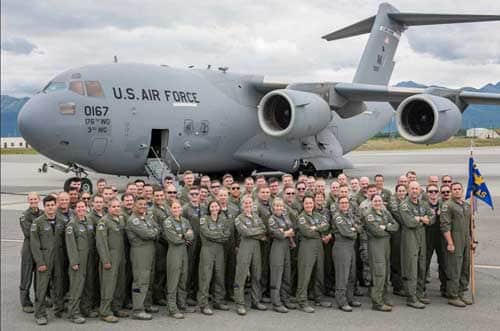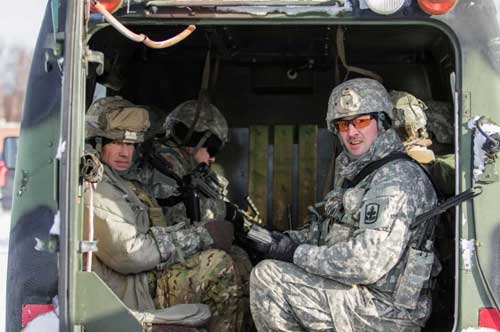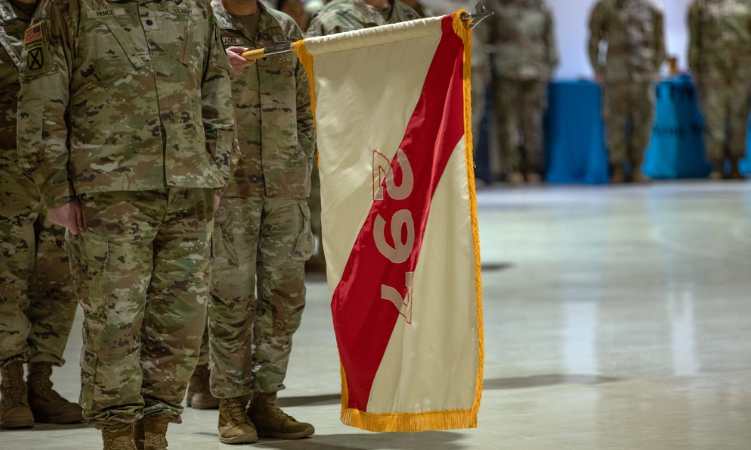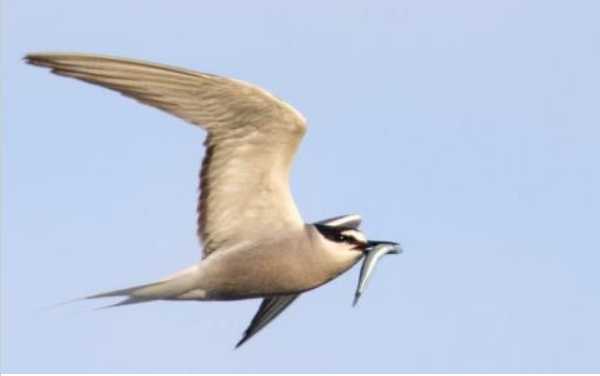
JOINT BASE ELMENDORF-RICHARDSON, Alaska — For Airmen of the 249th Airlift Squadron “Arctic Terns” and Soldiers of the 297th Regional Support Group, the C-17 Globemaster III cargo aircraft they were traveling on was a veritable time machine.
Leaving July 1 from Yokota Air Base, Japan, C-17 Tail No. 0168, Flight No. Reach 257, arrived at Joint Base Elmendorf-Richardson, Alaska, late on the evening of June 30.
Occupying the role of Dr. Who was Alaska Air National Guard Maj. David Lang, aircraft commander of the Globemaster.
The C-17 wasn’t a TARDIS capable of contorting the fabric of space-time. Lang and co-pilot Lt. Col. Greg Yoschak simply piloted the aircraft over the International Dateline on the way to Chinggis Khaan International Airport, Mongolia, to retrieve several dozen Alaska Army National Guardsmen and a handful of 716th Explosive Ordnance Detachment Soldiers who participated in Khaan Quest 2018 for three weeks.
Khaan Quest is a combined (multinational) joint (multi-service) training exercise designed to strengthen the capabilities of U.S., Mongolian and other partner nations in international peace support operations.
The return trip, mirroring the C-17 crew’s journey out to Chinggis Khaan, required two legs – a five and a half hour hop from Mongolia to Japan and seven and a half hour leg from Yokota to JBER.
Lang and Yoschak said the landing approach in Japan was pretty standard despite being next to the world’s most populous metro area and offering a bird’s-eye view of Mount Fuji.[xyz-ihs snippet=”Adsense-responsive”]The approach to Chinggis Khaan International differed from landing at U.S. air bases, Lang said, because the tower gave him instructions using metric measurements — meters and kilometers instead of feet and knots, which required quick conversions on the part of the pilots.
After mandatory crew rest, the Airmen met their passengers and cargo the following morning. Tech. Sgt. Jennifer Fitzpatrick and Tech. Sgt. Thomas Hough, loadmasters with 249 AS, had their hands full with a 5-ton truckload of duffel bags, ruck sacks and storm cases. Normally handled by Airmen assigned to base joint mobility complexes, the loadmasters took it upon themselves to liaison with the Army unit and supervise the pallet configuration.
Despite cargo brimming over the rails of the truck’s huge bed, Fitzpatrick and Hough managed to work with the Soldiers to pack the majority of the equipment on two 463L pallets, aluminum 9-by-7-foot pallets that snapped into the C-17 floor like metal Lego blocks. The Soldiers duffel bags were neatly and strategically laid in alternating north-south and east-west oriented layers, making for a green Lincoln Log like load that ensured maximum stability in flight.
Once the pallets were packed, the loadmasters estimated the weight of the cargo and the passengers, and arrayed them throughout the cavernous cargo hold of the Globemaster to make for an optimal center of balance.
Meanwhile, Staff Sgt. Troy Kennedy, 703rd Aircraft Maintenance Squadron flying crew chief, conducted pre-flight checks to ensure the aircraft was in top running shape. If he had found any major faults in Mongolia, he said he could call on backup maintenance personnel to assist. If faults were discovered in Yokota, he would work with base maintenance Airmen to quickly get the iron bird back into service.
Once the cargo was secured and the passengers were buckled in, Hough briefed the Soldiers on safety procedures and administrative requirements, injecting humor in an effort to add levity to a long flight.
“Are there any small children on this flight?” he asked when explaining oxygen mask procedures, before showing passengers how to use a hood-style backup oxygen mask, “which will probably be the only time your mother won’t yell at you for pulling a plastic bag over your head.”[xyz-ihs snippet=”Adversal-468×60″]
Most likely because the Soldiers endured a 3 a.m. wakeup after three weeks of marginal sleep, Hough’s comedic efforts were met by scattered chuckles.
Still, passenger safety was serious business for the Airmen. Fitzpatrick said two loadmasters were assigned to the flight because there were more than 40 passengers, and having a pair granted them the ability to assist as needed.
In Japan, the loadmasters had the pallets weighed in an effort to re-validate the aircraft load. After a night or rest for aircrew and passengers, both rendezvoused the next morning to repeat the process for the final leg home.
Because the flight was returning from an international location, the loadmasters’ job included prosaic tasks such as handing out and collecting customs forms, and ensuring passengers disposed of any non-American meat or produce.
Touching down at JBER, the crew of C-17 Tail No. 0168 had crossed space and time to return the Soldiers to their home in Alaska after their Mongolian adventure.
“I know you had absolutely no choice in travel, but thanks for flying with us anyway,” Hough beamed over the intercom.








